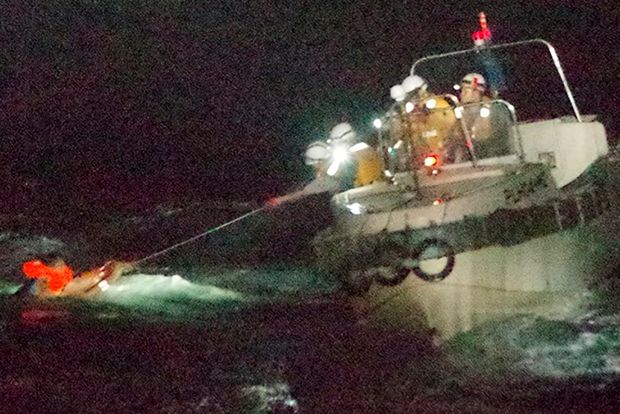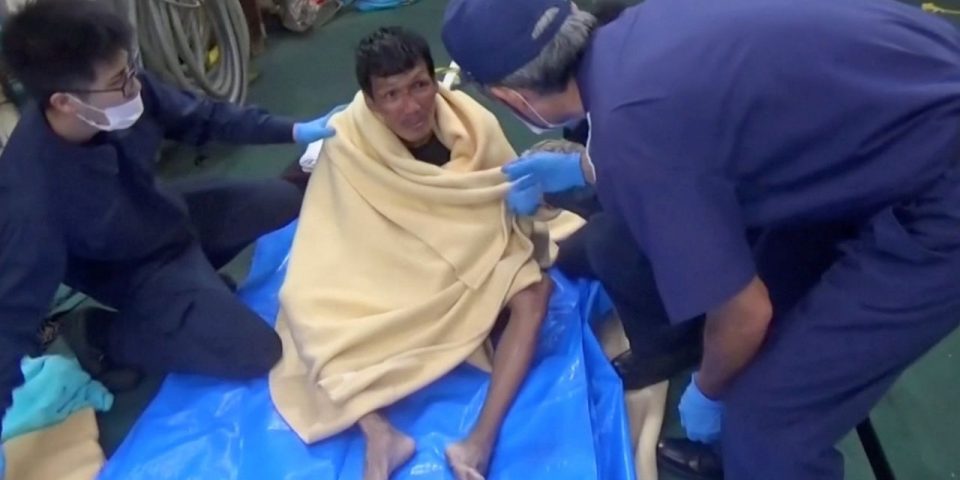New Zealand suspended shipments of live cattle after a vessel carrying more than 5,800 cows sank during rough weather on the way to China, leaving dozens of sailors missing and dead animals floating in the sea.
The large cargo ship called Gulf Livestock 1 was traveling from Napier, on the eastern coast of New Zealand’s North Island, to an international seaport about 170 miles from Beijing. Japan’s coast guard received a distress signal from the vessel at 1:44 a.m. on Sept. 2 from the East China Sea as a typhoon passed through the area.
Only two survivors among the 43 people who were on board the ship have been found so far. One of them told the coast guard that the ship capsized after an engine stopped and it was hit by a large wave. The second individual, who identified himself as a 30-year-old Filipino crew member, was found Friday in a life vest floating on a life raft slightly more than a mile from a tiny island called Kodakara. A third person was found unconscious Friday and pronounced dead. A search-and-rescue operation involving three ships, three aircraft and divers is continuing as another typhoon approaches the area.
The accident has drawn global attention to the business of trading and shipping livestock around the world in giant vessels with multiple floors of penned animals.

A file photo of the Gulf Livestock 1, which capsized this week after an engine stopped and it was hit by a large wave, one surviving crew member said.
Photo:
Graham Flett/Associated Press
For years, cows, sheep and goats bred in New Zealand, Australia and other countries have been transported by sea over days or weeks to China, the Middle East and mostly developing countries, where they are sent to farms or slaughterhouses. More than 31 million live cattle, buffalo, sheep and goats were exported in 2018, the most recent data available from the Food and Agriculture Organization of the United Nations.
The ship that went missing was owned by
a Dubai-headquartered shipping company. “Our hearts go out to those onboard and their families at this time. We also express deep regret for the sad loss of the livestock on board,” it said in a statement. “We pray that there are other survivors.”
On Friday, a spokesman for New Zealand’s Ministry for Primary Industries said the country is temporarily halting new cattle livestock-export applications while it tries to understand what happened during the Gulf Livestock 1’s journey.
The thousands of animals bound for China were dairy cows, as New Zealand had banned the export of livestock for slaughter. China has in recent years been importing cows to expand the country’s milk production. The trade has been lucrative for farmers in the Pacific Island nation who have a surplus of heifers, or female cows, partly because artificial insemination has enabled them to determine the sex of calves they breed.
Even before the accident, New Zealand had been reviewing the practice of shipping so-called breeding animals overseas.
Animal rights groups have heavily criticized the squalid conditions that animals are subject to while they are being transported, and at their final destinations.

Japan’s coast guard rescuing a crew member Wednesday. A total of 43 people were on the ship.
Photo:
10th Regional Japan Coast Guard /Associated Press
In 2018, a video released online showed thousands of sheep dying from heat stress aboard a ship traveling from Australia to the Middle East and prompted the Australian government to investigate the matter. New rules have since been introduced including a ban on sheep being exported to the Middle East in the hot summer months of June to mid-September. Last year, a vessel carrying roughly 14,600 sheep capsized after leaving a Romanian port, trapping the animals in their cages and causing them to drown.
Mark Harvey-Sutton, chief executive of the Australian Livestock Exporter’s Council, said efforts have been made to protect the welfare of the animals while they are being transported. The cargo ships are certified vessels and have veterinarians and other people on board who are trained to look after livestock, for instance.
While there have been unfortunate incidents, “the voyage itself has generally been pretty good” for the majority of cattle shipments, he said in an interview.
Recently, the coronavirus pandemic led to higher demand for live sheep from buyers in the Middle East, where the animals are slaughtered upon arrival. Scores of flight cancellations have led to a sharp drop in air freight capacity, which has reduced the amount of fresh chilled meat that can be sent to those countries, Mr. Harvey-Sutton added.
Lynn Simpson, a veterinarian who previously undertook 57 voyages on ships carrying livestock, is now advocating for live shipments to be banned. She says the crowded conditions on board the ships mean animals have to take turns to sit on floors covered in excrement.
“We do take these ships into some particularly dangerous parts of the world [in terms of weather], and I just don’t think it’s fair on the animals,” she said, adding that alternative arrangements could include sending genetic material like embryos and semen abroad instead of live animals.
Write to Lucy Craymer at [email protected] and Chieko Tsuneoka at [email protected]
Copyright ©2020 Dow Jones & Company, Inc. All Rights Reserved. 87990cbe856818d5eddac44c7b1cdeb8


